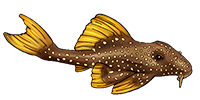Laser corys
Laser corys
I was looking for info on the laser corys. Can anyone tell me their scientific names. Thank you,
Scott
Scott
- Chrysichthys
- Posts: 1331
- Joined: 09 Jan 2003, 17:22
- My images: 1
- My cats species list: 43 (i:0, k:0)
- Spotted: 1
- Location 1: Oxford U.K.
- Interests: catfish!
- kim m
- Posts: 610
- Joined: 13 Nov 2004, 00:07
- My cats species list: 49 (i:0, k:0)
- Location 1: Denmark
- Interests: Pike and Carpfishing, Aquariums (mainly corys)
The laser-Corys have not been scientifically proven to be varieties of C. aeneus (or C. melanotaenia for that matter) so they might as well be a species ( or more than one species) of their own.
I've bred green lasers and they're quite different from C. aeneus when it comes to egg numbers and egg size. I regard them as a seperate species.
I've bred green lasers and they're quite different from C. aeneus when it comes to egg numbers and egg size. I regard them as a seperate species.
Best regards,
Kim M
-----------
Catfish Study Group
Guardians of Catfish
Skive Akvarieforening
Kim M
-----------
Catfish Study Group
Guardians of Catfish
Skive Akvarieforening
- Coryman
- Expert
- Posts: 2119
- Joined: 30 Dec 2002, 19:06
- My articles: 12
- My catfish: 5
- My cats species list: 83 (i:3, k:0)
- My BLogs: 1 (i:0, p:46)
- Spotted: 194
- Location 1: Kidderminster UK
- Location 2: Kidderminster, UK
- Interests: Cory's, Loricariids, photography and more Cory's
- Contact:
The 'Laser' Corys (Green & Gold) have not been proven as varieties of C. aeneusby science or anyone else for that matter. However they are considered by many, me included, to be closer related to C. melanotaenia than any other species. They are far more difficult to breed and are far more secretive in their behaviour than C. aeneus.
Ian
Ian







